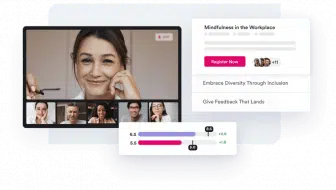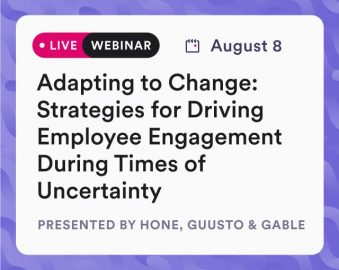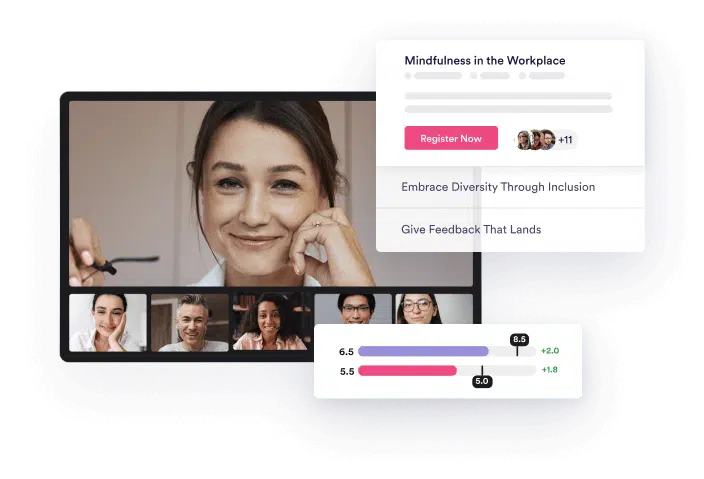Conflict can happen in any workplace. Sometimes, it can even have a positive effect on your team – allowing your employees to hear different perspectives on problems and, ultimately, pushing them to find more creative solutions. Unfortunately, most workplace conflicts are detrimental to employee well-being, especially when not addressed and resolved swiftly and effectively. As an L&D lead, training your people managers to identify, mediate, and resolve workplace conflict is a key part of your job. By teaching managers these skills, they can tackle issues head-on and ensure every employee feels valued and supported at work. Not sure what the best conflict resolution framework to teach your team is? Try non-violent communication.

Non-violent communication aims to fulfill our strong need to feel heard and listened to. It replaces defensiveness and aggressiveness with compassion and empathy, not only improve relationships and build trust, but also to resolve workplace issues in a timely manner.
Here’s an in-depth look at what non-violent communication is, why it matters, and how to teach it to your people leaders:
What is Non-Violent Communication?
According to The Center for Nonviolent Communication (CNVC), non-violent communication “helps people peacefully and effectively resolve conflicts in personal, organizational, and political settings.”

Developed by American psychologist Marshall Rosenberg, non-violent communication goes beyond just peaceful interaction. It’s a way of connecting with others, leading with compassion, and acting with empathy.
What are the Benefits of Non-Violent Communication?
While using non-violent communication has many benefits, here are a few ways this practice can have a positive impact on your workplace:
- It creates a clear step-by-step process for navigating conflict.
- It focuses on the underlying factors of conflict, like needs and emotions.
- It does not “wrong” anyone and makes space for all experiences.
- It creates an objective way to name the “facts” before jumping into emotions.
Why Non-Violent Communication is Important
For many people, putting others first doesn’t come naturally. Emotional intelligence and empathy are two skills L&D teams need to teach their people leaders. Being able to understand why an employee is upset or identify what they need during a conflict allows managers to be more compassionate, cultivate mutual understanding, and, ultimately, foster a more productive path forward built on trust.

Our emotions are a gateway to better understanding our needs in conflict. Having the skills to read a situation and people helps your employees more effectively determine the underlying needs driving conflict so they can quickly resolve issues.
The 4 Steps of Non-Violent Communication
Looking to teach your people leaders how to use non-violent communication to resolve conflicts? Here are the four simple steps you can teach managers to help them use non-violent communication to resolve workplace conflicts:
1. Observations
To begin, remind your managers to remain objective when they observe a conflict. You need to explicitly distinguish between judgment and observation, so your team knows exactly what “observation without evaluation” means. Approaching a conflict with preconceived notions or mentioning office gossip or hearsay can damage a manager’s relationship with an employee and undermine trust. To keep employees from becoming overly offensive, encourage managers to keep a neutral, objective tone throughout a conversation.

Instruct managers to ask questions like:
a. Can you tell me what happened from your point of view?
2. Feelings
Next, you’ll want your people leaders to ask questions that help deepen their understanding of an employee’s feelings from thoughts. Identifying how an employee feels after or during a conflict can help your manager better understand what needs to be done to rectify the situation.

Instruct managers to ask questions like:
a. How are you feeling?
b. How do you feel about what happened?
c. What two or three emotions are coming up for you?
d. What do you feel most {enter emotions} about?
3. Needs
When employees’ needs are met, they are happy. When they aren’t, they can feel uncomfortable, frustrated, angry, anxious, and more.

Every workplace issue can usually be tied back to someone’s needs not being met. Maybe your direct report didn’t feel heard when a colleague spoke over them in a meeting. Maybe a teammate felt undervalued when they didn’t receive recognition after completing a large project. Or, maybe an employee felt disrespected when a colleague said a microagressive comment.
Being able to identify those needs is crucial to resolving a conflict peacefully in a way that every party feels understood.
Instruct managers to ask questions like:
a. What needs of yours are not being met?
b. What do you really want?
c. Why is this important to you?
d. What top needs of yours are not being honored?
4. Requests
Lastly, you need to agree on what concrete actions to take to resolve an issue. This is often the hardest step because you may have to balance the needs of both parties and act as a mediator until a compromise is reached. Still, every conflict has a resolution. With the right training, your managers can expertly guide employees to a resolution and work together with their team to ensure this issue doesn’t happen again.

Instruct managers to ask questions like:
a. What would you like to happen? What support do you need?
b. How would you like to move forward?
c. What support do you need?
d. What is your request?
Non-Violent Communication in the Workplace
Non-violent communication is a critical skill for creating a positive and collaborative workplace culture. By focusing on empathy, active listening, and open dialogue, organizations can foster a culture of non-violent communication that leads to better relationships and improved business outcomes.
Practicing non-violent communication enables individuals to better understand their own emotions and those of others, leading to more productive and harmonious relationships. Non-violent communication also creates a safer environment for employees to share their ideas and concerns, leading to increased innovation and creativity.
By investing in non-violent communication training and promoting a culture of empathy and understanding, organizations can create a workplace where employees feel heard and valued, leading to improved morale and retention of top talent.
Non-violent communication is a muscle. The more you do it, the easier it becomes. When developing a training plan for your employees, be sure to incorporate plenty of role-play scenarios so students can practice these skills first-hand. By prioritizing empathy, active listening, and open dialogue, organizations can foster a culture of non-violent communication that leads to improved relationships and better business outcomes.
Looking to improve your non-violent communication skills or think this is a skill your employees need to sharpen? Check out Hone’s Managing Conflict classes. Sign up for a free 30-day trial for you and your team to try Hone for yourself.










